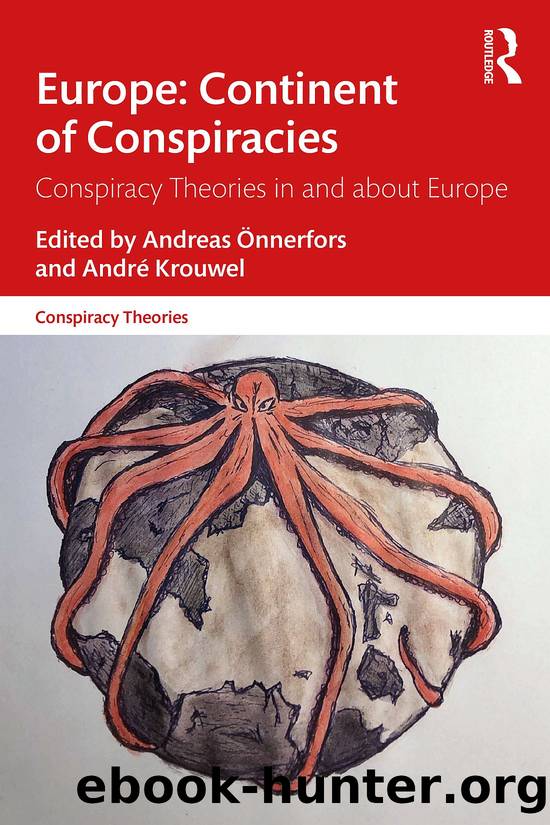Europe: Continent of Conspiracies: Conspiracy Theories in and About Europe by Andreas Önnerfors & Andre Krouwel

Author:Andreas Önnerfors & Andre Krouwel [Önnerfors, Andreas & Krouwel, Andre]
Language: eng
Format: epub
ISBN: 9780367500689
Google: OXcDzgEACAAJ
Goodreads: 55834591
Publisher: Routledge
Published: 2021-01-15T08:41:46+00:00
(To Vima, 2013)
In this excerpt, the austerity measures are compared with the attempts of an empire to prevail over the neighbouring countries. The second example in the first chapter of this analysis makes the same comparison, as it emphatically relates loan interest rates to tanks. Although there is no explicit metaphor that the financial crisis is a war, it is indirectly constructed by the syllogism that modern empires use alternate methods to establish themselves rather than military means. Thus, the reference to war machinery is restricted only to tanks, but this restriction does not affect the expressiveness of the metaphor. On the contrary, this is exactly the scope of this metaphor, to make clear that nowadays is possible to have a war without the use of war machinery, such as bombs and weapons.
It is noteworthy that the newspaper Makeleio in example 3, explicitly outlines the opinion that there is no need for war machinery in order for a war to exist and compares the austerity measures with the tactics of a great power. In this article, which expresses the opinion that the consequences of German financial policy are the same as those of a war, the metaphor fiscal politics is war is constructed directly. The source domain is the war, a concept that is known and simple, while the target domain is the policy and specifically the fiscal policy during a crisis. This correlation simplifies the motives and consequences of Germanyâs policy within the European Union and its role in combating the crisis. If politics is compared to a war, only one motive and one consequence of its implementation are emphasised, namely the attempt of Germany to rule over Europe. This kind of metaphor is crucial for the discursive construction of the conspiracy theory that Germany wants to build an empire and subjugate Europe, as it divides the European countries in two groups, a strategy that plays a vital role in conspiracy theories, as noted earlier. On the one side, is Germany that wants to win in this war, and on the other side, are the rest of the European countries that are the losers and are thus victimised. The narrative of conspiracy has victimisation to appear as an imperative.
The complexity of policies, the diversity of decisions, the mistakes that are often made, and the various motives and goals that influence the setting of a plan to fight the financial crisis are drastically simplified by this metaphor. A conspiracy theory that sees a specific motive or conspiracy behind each decision needs this simplification and rejects these complicated features. Simplification as a feature of metaphor makes conspiratorial texts easier to be understood and reproduced, but metaphors have also another function. The correlation between the target and the source domain ânamely between Germany and an empire as well as between its fiscal policy and a war â lends the conspiracy theory liveliness so that it has a persuasive effect. Both features of simplification and liveliness are crucial factors in spreading a conspiracy theory and constructing a dualistic world of good and evil.
Download
This site does not store any files on its server. We only index and link to content provided by other sites. Please contact the content providers to delete copyright contents if any and email us, we'll remove relevant links or contents immediately.
The Secret History by Donna Tartt(18849)
The Social Justice Warrior Handbook by Lisa De Pasquale(12142)
Thirteen Reasons Why by Jay Asher(8796)
This Is How You Lose Her by Junot Diaz(6794)
Weapons of Math Destruction by Cathy O'Neil(6146)
Zero to One by Peter Thiel(5686)
Beartown by Fredrik Backman(5599)
The Myth of the Strong Leader by Archie Brown(5425)
The Fire Next Time by James Baldwin(5249)
How Democracies Die by Steven Levitsky & Daniel Ziblatt(5128)
Promise Me, Dad by Joe Biden(5087)
Stone's Rules by Roger Stone(5026)
A Higher Loyalty: Truth, Lies, and Leadership by James Comey(4845)
100 Deadly Skills by Clint Emerson(4840)
Rise and Kill First by Ronen Bergman(4704)
Secrecy World by Jake Bernstein(4646)
The David Icke Guide to the Global Conspiracy (and how to end it) by David Icke(4625)
The Farm by Tom Rob Smith(4438)
The Doomsday Machine by Daniel Ellsberg(4416)
